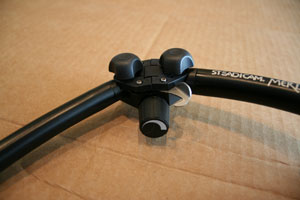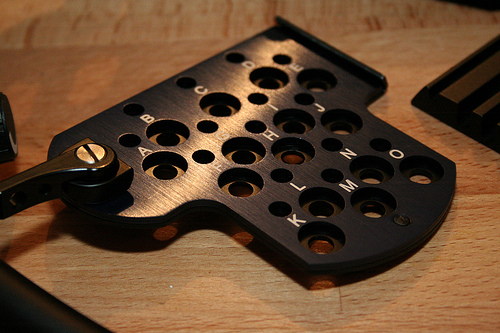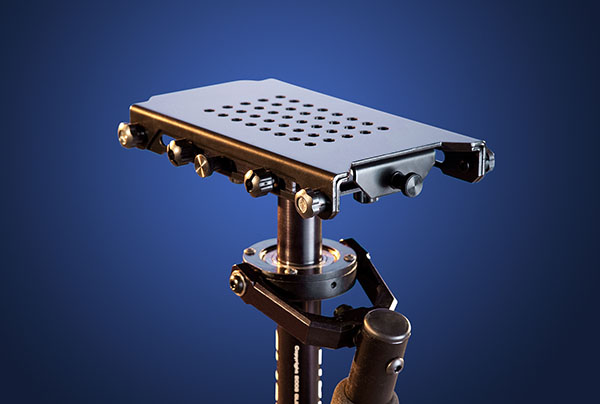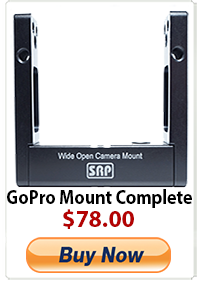STEADICAM MERLIN: WHAT YOU NEED TO KNOW
The name Steadicam is the premium marque of stabilising equipment, designed by inventor and all-round legend Garrett Brown. The Steadicam range is pretty vast these days, catering for all sizes of cameras from monster iMax behemoths (as on Dark Knight) to a tiny video camcorder. The lightweight size of DSLRs ought to be ideally suited to the baby of the range, the Merlin, which can handle cameras up to 7 pounds. But I’m sorry to say it’s not.
I own a Merlin and have worked a fair bit with the Glidecam 2000, the best known competitor to the Merlin and though both have their faults and plus points the Glidecam seems to offer a better experience. Last night I had a chance to try a B-Hague stabiliser which shares many of the same design traits as the Glidecam 2000, and it too was better than the Merlin. We had all three on the shoot and the Merlin was dumped early on in the process, despite the ease with which you can balance it.
But why?
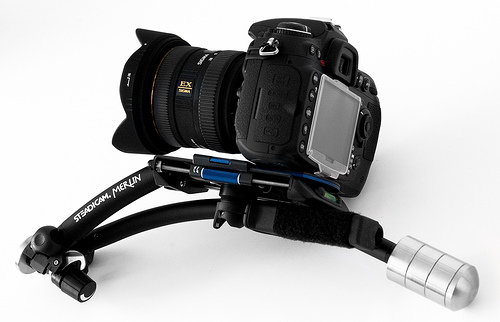
The Merlin has been designed so that the centre of gravity of the whole unit sits directly over your hand as you grip the handle. This means it’s much easier on the wrist than the Glidecam where the centre of gravity sits a few centimetres ahead of your hand. May not sound like much but it makes a big big difference. In order to achieve this design the Merlin does away with the central post that characterises every single other stabiliser system. With the post the operator can spin the camera 360 ad infinitum in both directions. This you cannot do with the Merlin. This also means there are some interesting countering forces acting on the rig as the weights at the centre and bottom stages fight against each other, keeping the Merlin stable. This design innovation is actually the Merlin’s achilles heel in more ways than one.
Firstly, though it’s actually pretty straightforward to adjust the balance of the Merlin once you’re close, actually getting it close is a huge undertaking (more on that at the bottom of this post). You can be pretty fudgey with the Glidecam but it will still give you a pretty decent result. Anything slightly off perfect balance will result in massive amounts of ‘boating’ with the Merlin where the rig sways uncontrollably side to side. This problem is also compounded by the neat hinge that breaks up the spar arc (the long tail) of the Merlin. The dangling tail of the spar arc does not lock into place and as a result it’s actually very easy to knock it. Tiny variations in balance are enough to ruin the stability of the rig so the only way to ensure the arc is at full lock is to pull it out as far as it goes. The joint is stiff so it’s quite easy to knock it a little bit but for the bottom part of the arc to remain where it is rather than drop back down to its lowest position. You’re off balance again.
The next problem lies in the single screw tripod plate on the bottom of DSLRs. A single point of contact means the camera can easily rotate on the mounting plate (called a dove plate) and, once again the tiniest rotation left or right will leave the Merlin desperately listing. Once again this problem is compounded by a number of issues. Firstly, DSLRs are not video cameras. Duh. The DSLR body is wide but not long with a huge weight hanging out the front in the shape of a lens. Video cameras feature a much longer base in contact with the plate and are therefore much more stable. The majority of movement on stabilisers is front and back and so this axis of movement needs to be the most stable, but in DSLRs it’s the least stable. The short base of the DSLR means there is a huge levering effect from the lens putting pressure on the single thread that holds the camera to the plate. This causes the camera to bounce up and down, a problem made worse by the relatively flexible nature of the plate. Add to this a final problem that the camera’s centre of gravity is a long way from the stablest point where it connects to the plate and this means you have to attach the camera to hole ‘O’, one of those sitting furthest back on the dove plate. The holes here are much less stable than those in the middle. In order to keep the plate locked firmly to the camera you have to tighten the screw an enormous amount. This deforms the plate meaning it doesn’t sit flush with the very small surface area of contact with the camera. More bounce, more problems. How’s this different to the Glidecam? The Glidecam features a steel plate, and a big one at that and the DSLR is given much less freedom to pivot around or flex on the stage so it is much more stable. To be fair the Merlin does feature a hole where you can add what they call a ‘Gesornen Platz screw’ to restrict the movement of the camera but I still find this a tricky bit of kit to get in the right place and often the lens won’t reach it.
The final greatest issue with the Merlin is that you can’t put it down without affecting the balance. It has to lie down on its side which means the weight of the lens is now acting on the rotational axis of the camera around the screw that attaches it to the dove plate. Yes, it rotates out of position and you have to rebalance. The Glidecam has a stable enough foot to simply put it on the ground, and you can grab it as and when you need without having to rebalance.
Now, I have had some good results with the Merlin, but I finally had to concede last night that it’s simply not very good for DSLRs and I would advise against buying one for that purpose. I will add that I tried a Canon XHA1 (which features a locking pin to keep the camera set on the stage) and it worked beautifully, really well. For DSLR stabiliser uses I have to say the Glidecam is the one to get. I went with the Steadicam name and the ease of managing the weight but you don’t care about how heavy it is (you can always do some weights!) once you see the shots in post production. I actually wrote an article comparing the two a while back and I plumped for the Merlin in the end because I felt it was more agile and repaid practice with more refined results but you know what I just can’t live with its faults anymore.
Now, let’s say, like me, you do have a Merlin and you can’t get the damn thing to balance. How do you do it? I spent ages trying to come up with the ideal recipe. And here it is. I’m not going to go into the fine details of how you achieve perfect balance with the length of the spar arc as that’s best served with a video but this is a great starting point for pretty much any DSLR lens.
DOVE PLATE: hole ‘O’
MIDDLE: 2 Mid weights
BOTTOM: 4 Mid weights
Z-SCREW: this is the adjustment you can make to the distance of the gimble from the stage. Rotate it all the way in (clockwise) then unscrew 8 turns anti-clockwise.
DOVE PLATE STAGE SETTING: A nudge in front of -1 (you can adjust this easily to taste)
Getting the balance right depends on getting the drop time down to just under a second with big adjustments to the spar arc and countering adjustments to the trim on the stage. Keep going with that gradually reducing the size of the adjustments till you have that golden 1 second drop time. You can easily get the rig balanced between the forward/aft and left/right axes but the key to a really good stabilised rig is getting the drop time just right. The only way to explain this is in a video but I’m working on that right now. For now, start with the settings as above and you should be in good shape.
Or, sell the Merlin and get a Glidecam 2000, it’s half the price too.
-
http://YourWebsite Joey
-
El Skid
-
matthew20
-
kevin
-
Anonymous
-
http://twitter.com/QuartoSoft Fabio Bersani
-
Ninamit
-
http://profiles.google.com/4dbill Bill Voelker
-
Anonymous
-
ELLIOT STERN
-
Paul Milngavie

